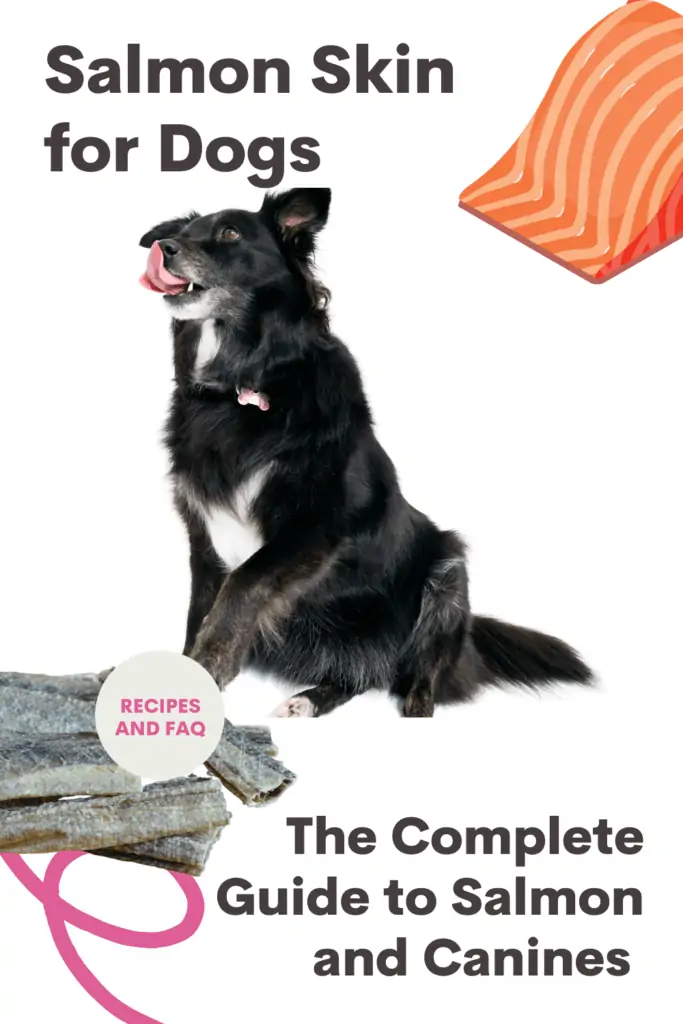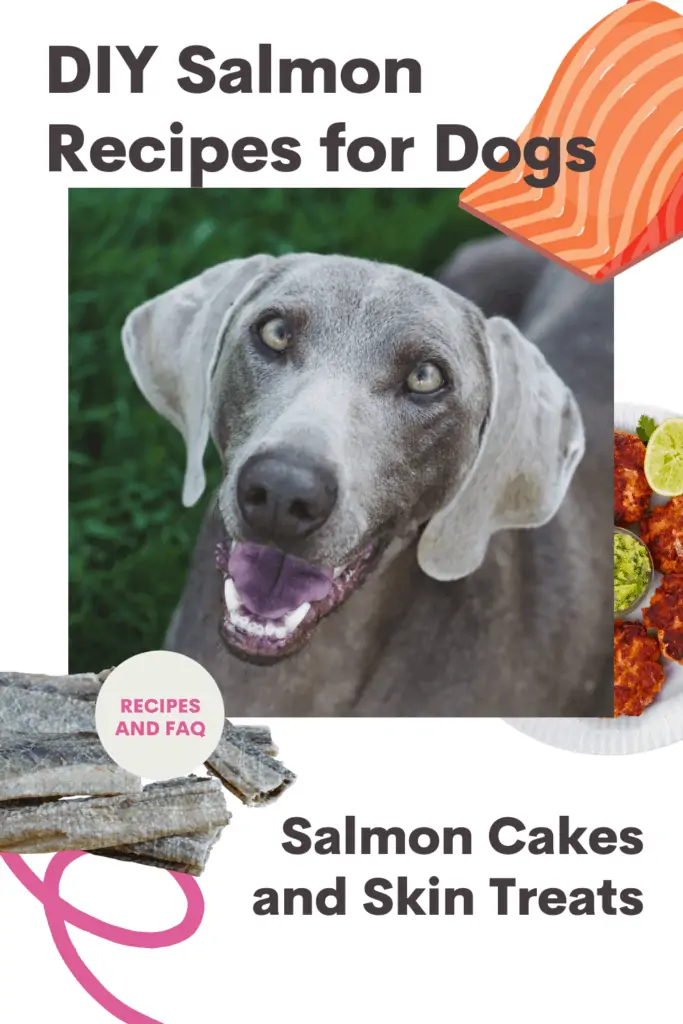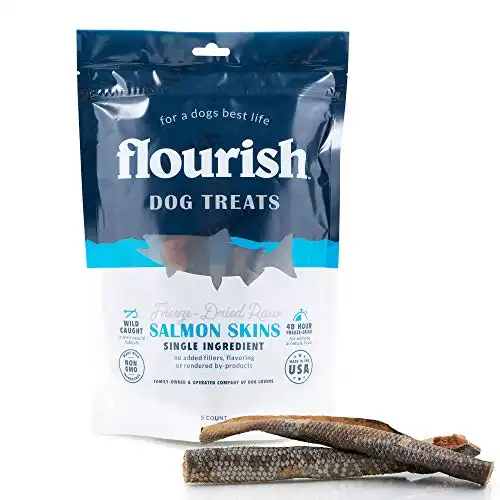Salmon Skin for Dogs – Complete Puppy Guide to Salmon
Salmon is considered a superfood for humans. It is a white meat that is full of fats and nutrients that your body needs.
Many Asian countries that include salmon as a regular part of their diet attribute their skin quality to the fish. The fish also has other health advantages, such as increased life expectancy.
Salmon works the same for dogs, especially if it is properly prepared cooked or as fish skin treats. It is a smart and convenient addition to your dog’s diet. In fact, cooked salmon is a common ingredient in most dry and wet dog food.
If your pet is allergic to chicken, another common and cost-effective protein source, then salmon dog food is a tasty alternative.

Nutrition Benefits of Salmon for Dogs
Salmon gives a generous serving of omega-3 fatty acids and proteins. It is considered the healthiest kind of fish for both you and your canine buddy.
This fish is also rich in amino acids, vitamins A, B-complex, D, and minerals, including magnesium, potassium, and zinc.
A regular dose of salmon in your pet’s diet is extremely beneficial.
Here are some of the health perks of salmon for your pet:
- Good for their skin and fur
- Helps improve any skin irritations (healthy skin)
- Aids in reducing any effects of skin allergies
- Promotes better joint mobility
- Stimulates cognitive and cardiovascular function
- Reduces joint inflammation
- Strengthens the immune system
- Improves brain function
This is why many dog foods and treats contain omega-3 – because it is deliciously healthy and a good source of beneficial nutrients.

Salmon Skin for Dogs
Fish skin, including that of salmon, is a potent source of omega-3 acids. It is not only safe for your dogs but vital as it increases their immune levels.
However, salmon must never be given raw—especially salmon skin. Salmon skin does have parasites, and if not cooked properly, it can result in salmon poisoning. (Similar to pork for dogs – it needs to be cooked) If you’re not familiar with salmon poisoning, please note that it is fatal for pets, unlike food poisoning in humans.
So, check the skin for tiny bones that can affect your furbud’s gut health, and cook the skin adequately.
If you’ve ordered salmon from your favorite restaurant, don’t hand it to your bud until you’re sure that it was cooked without ingredients that are toxic to dogs. Bear in mind, though, that salmon skin has a high-fat content and, as such, should not be part of your dog’s everyday diet.
A serving suggestion would be to peel off the cooked salmon skin and chop it into smaller pieces for dogs. Again, the idea is for it to be used as a treat and not a meal, so bite-sized skin chunks are the best way to go about it.
You can also purchase commercially ready dehydrated salmon skin treats for your fish-loving dog. Wild salmon is better than farmed salmon but realistically the difference for dog salmon skins is minimal.
Salmon Oil for Dogs

Another way of incorporating salmon into your dog’s diet is by using salmon oil.
Yes, salmon oil is perfectly safe for your dog, and it provides additional health advantages to only eating the fish.
Salmon oil is a potent omega-3 source, which plays a massive role in developing your dog’s cell membranes. Putting a few salmon oil supplements into your pet’s food is the most common approach.
However, make sure to follow the recommended dosage based on your pet’s age and weight. You can’t just put in five drops for lunch because more is better! It does not work that way – even with healthy fats.
After initial use, observe your pet for any possible adverse reactions to the oil. This will include monitoring your bud for loose stools, bad breath, and lethargy. If your dog shows any of these health warnings, stop using salmon oil and get him checked by your veterinarian.
Alternately, you can opt for a convenient and easier method—purchasing dog treats or kibble already supplemented with salmon oil.
How Should Salmon Be Served to Dogs
Being a flavorful source of protein, your dog will surely enjoy a salmon meal or tasty treat. Some dogs are considered seafoodies because of their great love for fish like salmon.
Salmon is generally a dog-approved and people-accepted canine food, but it is not something you can simply serve your dog.

Salmon should always be 100% cooked. If compared to meat, it needs to be cooked well-done or ready for some doggie troubles. Cooking salmon will kill any bacteria and parasites outside and inside the fish. If possible, use fresh and boneless salmon fillets.
Always make sure to check for fish bones before cooking. Any bones that your dog ingests can splinter in your dog’s mouth, especially if yours is still a puppy. It can also get lodged in their throat and gastrointestinal tract.
The best salmon to serve and share with your canine friend should be baked, poached, grilled, roasted, or steamed. It should not have garlic, oil, onions, pepper, or even salt. In fact, there should be no seasoning at all.
If you plan to give your furbaby a salmon treat, set aside a portion. Do this before you start seasoning and cooking your salmon with oil, garlic, and other whatnots that are not recommended for pets.
You can also use canned salmon, but make sure that it only comes with water and not oil or brine.
To make every salmon treat unique and something your dog can look forward to, you can add some salmon oil into your pet’s dinner bowl and reward a job well done with some salmon jerky or other salmon-based treats. However, limit the frequency of such treats to 2-4 times a month.
As with any food for both humans and dogs, portion control is a must. As much as you love your pet, only give an appropriate portion size.
DIY Salmon Dog Recipes
If you love tinkering in the kitchen and making special treats, then pamper your beloved furbaby by cooking some salmon treats. You can try these two easy recipes. If you love innovating, you can research online as well. You’ll find many free and simple recipes online.
For starters, these salmon dog treats and salmon cake will surely make your dog happy.
● Salmon Dog Treats
You only need three ingredients for these irresistible treats:
- One 14.75-ounce can of pink salmon in water
- 2 cups of flour
- 2 eggs
The baking instructions are just as simple:
- Preheat your oven to 350 °F.
- Put the salmon together with the water in the can into a mixing bowl.
- Flake the meat apart.
- Add the two eggs and mix well.
- Toss the flour into your egg–salmon mixture.
- Spray your baking sheet with a no-stick cooking spray.
- Pour your dough mixture onto the baking sheet.
- Sprinkle some flour on the dough and your hands to keep the dough from sticking.
- Press the dough flat on the sheet until it is about ¼ in thickness. If you want your salmon treats to be crunchy, make the dough thinner. If you want it moist, it has to be thicker.
- Put the tray in the oven.
- Bake it for 25 to 35 minutes based on your preference – crunchy or moist.
- Remove from your oven and let it cool on a wire rack.
- Cut and divide into smaller portions.
- Bag and store.
After baking, give your furry friend a few treats for patiently waiting. You can keep the rest and distribute it over two months.
● Salmon Patties for Dogs
This is an extra-special treat that you can prepare for your dog’s next birthday. Humans love salmon patties, so get those cooking skills roaring and create a dog-friendly version of this healthy goodness.
For the salmon patty, prepare the following ingredients:
- One 14.75-ounce can of salmon
- 2 egg whites
- 2 teaspoons dried parsley
- ¼ cup of sour cream
- ½ cup of shredded carrots
- ½ cup of plain bread crumbs
- 1 teaspoon of dried dill
Here is the step-by-step guide to making this dog-lickin’ yumminess:
- Preheat your oven to 350 °F.
- Drain the liquid that came from the canned salmon.
- Check to make sure there are no skin or bones.
- In a bowl, mix the carrots, egg whites, salmon, sour cream, and parsley to create the patty.
- In a separate dish, combine the dill and bread crumbs.
- Scoop a ball of the mixture using a 1-inch cookie scoop and flatten to form a patty.
- Coat the patty in the dill-and-crumb mixture.
- Set the patties on a lightly greased cookie sheet and bake for 12 minutes.
- Flip the patties so you can also bake the other side for another 12 minutes.
- Remove from the oven and let it cool.
One batch can produce 24 salmon patties. When completely cooled, you can spoil your dog with a patty or two. You can keep the remaining treats in the refrigerator for another week or, when frozen, up to two months.
Health Risks of Salmon for Dogs

Raw or even undercooked salmon is not recommended for dogs. This is because salmon contains bacteria and parasites that can make your dog sick. It can even be fatal, especially if your dog consumed a large portion of uncooked fish meat or skin.
Raw salmon is sure to have flukes. These are flat and worm-like parasites. If the salmon is infected with flukes and is ingested by your pooch, your dog might get sick. You have to keep an eye on your dog for gastrointestinal symptoms like diarrhea and vomiting, which will lead to dehydration.
Aside from flukes, undercooked salmon may also lead to salmon poisoning disease brought about by the bacteria Neorickettsia Helminthoeca. Your dog might exhibit one or some of these indicators when poisoned:
- Diarrhea
- Dehydration
- Enlargement of the lymph node
- Fever
- Vomiting
If left untreated for two weeks, you may even lose your beloved dog. Note that salmon poisoning symptoms won’t manifest until five to seven days after your dog ingests the raw fish.
This is a challenge when it comes to attempting to address poisoning in real-time. Usually, pet owners have a hard time connecting the raw salmon to the symptoms because the ingestion happened days ago.
Salmon poisoning only affects canines, which explains why cats, bears, and raccoons can eat raw fish without any risk.
Friendly Reminders When Giving Salmon to Your Dog

If you’ve decided to give your pet salmon treats, these key takeaways will help ensure that your pet enjoys all of the deliciousness and none of the issues.
- Always check that the salmon is 100% cooked before feeding it to your dog. As advised by the United States Department of Agriculture Food Safety and Inspection Service, fish should be cooked under a minimum internal temperature of 145 °F.
- Canned salmon is an alternative but don’t select the kind where the salmon is packed with oil or brine. It should always be with water only.
- Make sure that the salmon is completely deboned. You have to be meticulous in removing all the fish bones because they are harmful to your pet.
- Never feed your dog smoked salmon. This kind has too much salt content, which is harmful to your pet. It can also contain bacteria and parasites that the smoking process didn’t kill.
- Salmon that is cooked with seasonings like onions and garlic can be equally harmful to your dog. This is a complete no-no as dogs metabolize foods different from humans. Underground vegetables like onions and garlic can lead to hemolytic anemia. It doesn’t matter if you’ve done it before and your pet didn’t show any symptoms (pain, depression, dehydration, vomiting, etc.), discontinue that practice.
Final Thoughts
Overall, salmon is safe for dogs, and with its health benefits, it’s good to include it in their diets.
Although salmon is a superfood, note that your pet will need another source of carbohydrates, protein, and other vitamins. So you can’t rely on salmon alone for your dog’s essential needs.
Salmon – in any form – serves just as a supplement to increase your dog’s health quotient. So don’t overdo it and limit salmon to treats 2-4 times a month.
Make sure the salmon is fresh, deboned, and wholly cooked so that you and your fur buddy can enjoy the meal without any adverse reactions.
